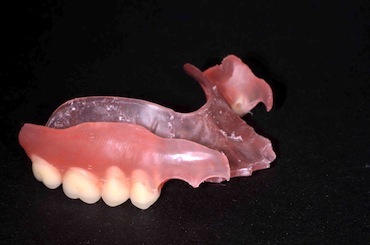Understanding Removable Partial Denture Materials
By Mary Anne Salcetti on July 4, 2016 | I am sure that at least one time in every dentist’s career they had to struggle with an improper fit and consequent patient discomfort of a removable partial denture (RPD). It can happen often enough to make one start referring those cases out or for patients to find another dentist they believe can make them more comfortable.
I am sure that at least one time in every dentist’s career they had to struggle with an improper fit and consequent patient discomfort of a removable partial denture (RPD). It can happen often enough to make one start referring those cases out or for patients to find another dentist they believe can make them more comfortable.
The good news is that we have had a dental materials shift away from the prototypical vitallium/acrylic where fitting the metal framework can be challenging.
The material I recommend is called iFlex by tcs. It is a biocompatible thermoplastic material. It is durable and lightweight in addition to being comfortable, break resistant and ideal for patients allergic to acrylic. It is more natural in color and translucence than traditional materials as well as easier for the lab technicians to work with.
The biggest advantages of this material are fit and esthetics. Clasps and even rests can be designed into the framework and won't break (an eventual side effect of cast or wrought wire design). Patients love the fact that it is not bulky and feels thin and unobtrusive.
It is warmed in hot water one minute before seating and adapts easily to the tissues. When it cools to body temperature, it has a comfortable retentive fit.
There are only two potential problems I have found working with this material. The first problem is clinical. For those patients with knife-edge ridges and thin tissue, it can feel too tight and the borders of the appliance press in too hard on unforgiving thin tissue. Since the appliance is thin to begin with you don't have much material on the intaglio surface to start relieving.
The second problem deals with the laboratory, and it is in the adjusting and polishing. We are programmed to relieve acrylic with pressure and speed but this material will not respond with the heat generated from the pressure. You have to use short light strokes, which may require a little practice. Acrylic dust can be blown off, but the edges of the iFlex have to be polished with pumice and rag wheel and finished with its own polish on a chamois and with slow speed.
Even with those potential problems, I will seldom return to fabricating a RPD in the conventional metal/acrylic as the post op adjustments are less, and immediate patient comfort is high. I recommend you give this material a try on your next case.
(Click this link for more dentistry articles by Dr. Mary Anne Salcetti.)
Mary Anne Salcetti, DDS, PC, Spear Education Visiting Faculty. [ www.maryannesalcettidds.com ]
SPEAR SEMINAR: Treating the Terminal Dentition and the Fully Edentulous Patient
Take your treatment of edentulous patients to the next level with this two-day seminar. Explore the essentials of treatment planning and implant restorative design for the patient with terminal dentition and/or a fully edentulous condition.
LEARN MORE